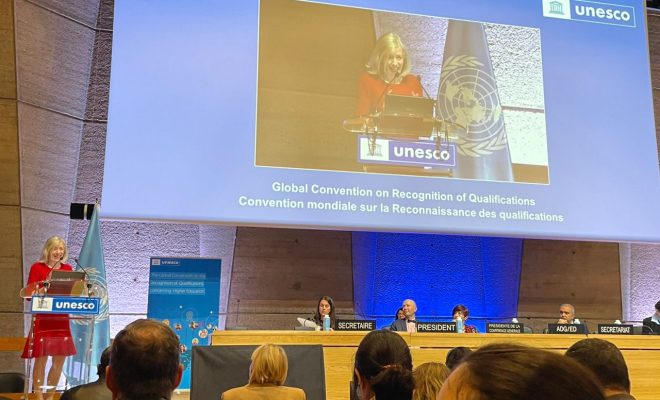How will COVID-19 affect international academic mobility?

By José Antonio Quinteiro Goris |Pandemics have plagued the world many times, disrupting the economic and social activities of millions of people, altering the culture and institutions of the societies in which they spread, impacting them at different degrees. The university is one of those institutions that pandemics have affected in a significant way, and at present, it is doing so in a manner that we do not fully understand.
Invoking historical analogies does not imply that COVID-19 will affect the future trajectory of universities in the same way that the Black Death (XIV century) or Smallpox (XIX century) did, mainly because we live in a historical time marked by all kinds of scientific conquests. However, scrutinizing history allows us to discover the actions and reactions regarding higher education that occurred after a great health and economic crisis like the one we are currently going through.
It is therefore worth remembering that 5 of the 30 universities that existed before the Black Death disappeared in the late 1350s due to little or no enrollment. However, the deaths also meant renewing the supply of clerical cadres lost to the pandemic, and this, coupled with a significant increase in donations, made it possible for schools such as Trinity Hall in Oxford and Corpus Christi College in Cambridge to exist. Likewise, donations, which were previously only for the poor and needy, were institutionalized.
The case of smallpox, a disease that ended with the life of one person out of ten, is linked to the development of the first vaccine. The empirical work of Edward Jenner (Oxford University, 1796) demonstrated the validity of the knowledge derived from experience and observation that today constitute the foundations of the scientific method. Since then, the fact that pandemics expose our weaknesses makes people take refuge in Science, which is ultimately the raison d’être of universities.
There is no doubt that the university will emerge stronger from this crisis, just as it did in the past. However, the changes will be profound because COVID-19 will not stop the digital revolution, which was already having a strong impact on the university, but it will rather strengthen it. The acceleration in the transition from an analog to a digital economy will affect the major sectors of production and consumption, of which educational services are part.
The impact will be particularly traumatic for countries that have internationalized their higher education; half of international students now go to the United States of America, Canada, the United Kingdom, New Zealand and Australia. Other destinations that were already conquering positions to snatch that primacy are expected to emerge, mainly Malaysia and South Korea, and their attractiveness will be favored by the low prevalence rate of the disease in their territories.
One of the reasons for this international competition to capture the flows of international academic mobility is due to the enormous amount of money it contributes to the inbound students’ countries. Only the Chinese student contingent represents 20% of the income of Australian universities, while for the United States of America it constitutes the fourth largest exporter, only behind its automotive, aeronautical and pharmaceutical industries.
Even considering these contributions to national economies, Australian Prime Minister Scott Morrison noted that it was time for international students to return home (‘time to go home‘), a statement that will undoubtedly weigh on the recruitment of prospective international students. Added to this is that the acting government has denied them the right to some $ 20,000 in work benefits and other aid exclusively available to Australian citizens.
The United States of America enacted the CARES (Coronavirus Aid, Relief, and Economic Security) Act, a stimulus package to deal with the pandemic. This financial aid reserves US $ 14 millions for the higher education sector (including a section for its international students), which has already been branded as “insufficient” by the American Council on Education.
Contrary to what happens in the United States and Australia, the United Kingdom, anticipating a 47% drop in foreign students for the next academic year, registers voices that suggest offering value-added bonuses (four-year work visas upon completion of studies, facilities for obtaining the British citizenship, etc.) with a view of mitigating this decline (Times Higher Education, April 25, 2020).
Without a doubt, the future enrollment rates of international students will depend on the measures and policies adopted by the governments of the recipient countries in the near future. Will there be travel restrictions for international students? Will the determinants that condition international mobility deteriorate? Everything seems to indicate that in the short term the scene will have the following features:
-Restrictions on the granting of visas to people from countries that have high prevalence rates of the disease;
-Psycho-emotional consequences that lessen the attraction of continuing the international mobility that was interrupted, or of embarking on a new experience of a similar nature;
-Global finance shrinking that will reduce public and private funds in favor of international mobility;
-54% increase in the cost of air tickets to implement social distancing in air passenger transport (IATA, May 6);
-Increase in the offer of virtual cross-border education;
-Visa restrictions will be a major barrier to international academic mobility. Health barriers to prevent the spread of the Coronavirus will be difficult to overcome for people coming from countries with a high prevalence of infection, particularly from the epicenters of infection (Wuhan, Northern Lombardy, Madrid, New York and others). In this regard, we found that the next available appointment to apply for a student visa in Beijing is November 29, 2020, although, of course, no sanitary reasons are given for such postponement (The PIE News, March 24, 2020).
The forced lockdown in their host countries also caused an internal breakdown, affecting the psychological security of many students, which is why there will be some who give up on their interest in pursuing studies abroad, regardless of whether they are in another country or not. As an illustrative example of this, we have approximately 5,000 African students who were in Wuhan, China, at the time of the outbreak of the pandemic and who were prohibited from leaving the city. Despite their despair and having contacted their respective consular authorities, the Chinese government urged these diplomatic representations to refuse to provide such aid.
The house confinements that were generally decreed around the world paralyzed global economic activity. With different degrees of impact, Spain – the preferred destination of the European mobility program ERASMUS Plus – foresees a fall in its economy of around 12,8% for 2020. For Latin America and the Caribbean, the fall is expected to be around 5.3% (ECLAC, April 21, 2020) pushing 29 million people into poverty.
For its part, the social distancing in aircraft cabins will mean an increase in air tickets of around 54% if the biological passport suggested by IATA is not approved; the latter, even without known details, raises great concern for its undeniable discriminatory tint. Likewise, expert voices predict the disappearance of so-called low-cost flights, which, with little incidence in Latin America and the Caribbean, accounted for 57% and 39% of air traffic in Asia and Europe, respectively (2017).
Lastly, cross-border higher education could be strongly strengthened and make traditional mobility less attractive by allowing students the opportunity to study subjects at a distance, with the certainty that the credits taken will be recognized by the higher education institutions of origin. The Virtual Mobility Space in Higher Education (eMOVIES,) under the leadership of the Inter-American University Organization, and the NetACTIVE program of the Erasmus Mundus are initiatives in this sense. The latter seeks to facilitate virtual mobility between Latin America and the European Union, and has the support of the Ibero-American Association for Distance Higher Education (AIESAD) and the European Association of Distance Teaching Universities (EADTU).
This virtual mobility model is defined as “the use of ICTs to obtain the same benefit as a student of physical mobility, without having to travel”. However, this new concept of “mobility without physical displacement” looks confusing when contrasted with e-learning or mobile-learning, even though credits for courses or subjects taken under virtual modality will be granted full recognition in the home institution.
It should be noted that virtual mobility is an emerging concept with application characteristics that have been forged in Europe within the framework of the European Higher Education Area and, without detriment to the potential it offers, it may still need more consolidated trajectories to find recognition in legislations of the Latin American and Caribbean countries, as well as in the New Regional Agreement for the Recognition of Studies, Degrees and Diplomas in Latin America and the Caribbean (2019).
To conclude, we can say that while the universities turned their sights to virtuality in order to ensure the continuity of the teaching-learning process, with the setbacks it encountered [and still encounters] for those institutions that had a low level of virtualization, academic mobility does not find the same correspondence of change in the arenas of virtuality. Consequently, international academic mobility will be frankly prostrated until the universities do not restart (partially or completely) face-to-face activities, and the conditioning factors of physical mobility do not offer sufficient porosity to allow significant flows of international academic mobility.
This conclusion is also reached when we project the immediate future of international academic mobility in Latin America and the Caribbean. However, it should be added that, in the two countries with the highest international student mobility, Argentina and Brazil, the first as a recipient and the second as an exporter of students, cause for concern has appeared as the number of those infected by COVID-19 continually increases and does not yet reach the peak that marks the decline of the pandemic.
José Antonio Quinteiro Goris, Program Coordinator of the UNESCO International Institute for Higher Education in Latin America and the Caribbean (IESALC).
Picture of Porapak Apichodilok on Pexels
RELATED ITEMS







